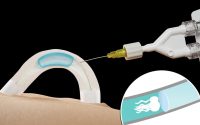How a new chewing gum could ‘trap’ COVID-19, reduce spread: study
Chewing gum can do more than freshen your breath — it can save a life.
A new study found that a medically crafted chewing gum could reduce the transmission of SARS-CoV-2, the virus behind the COVID-19 pandemic.
Conducted by the University of Pennsylvania’s School of Dental Medicine, researchers at Penn discovered the gum containing “plant-grown protein” acts as a “trap” for the virus.
“SARS-CoV-2 replicates in the salivary glands, and we know that when someone who is infected sneezes, coughs or speaks some of that virus can be expelled and reach others,” Henry Daniell, who led the study published in the journal Molecular Therapy, told Penn Today.
“This gum offers an opportunity to neutralize the virus in the saliva, giving us a simple way to possibly cut down on a source of disease transmission,” he added.
While vaccination efforts curbed fatalities, it hasn’t hindered transmission, as the Centers for Disease Control and Prevention still notes more than 124,000 average daily cases in the US. But as researchers hunt for a way to halt transmission, this gum could be a clue.

“While masks can prevent transmission to others, they do not protect re-infection of infected individuals,” the authors wrote in the study. “Therefore, chewing gum as a biomaterial offers novel and practical applications during the current pandemic.”
In the body, angiotensin-converting enzyme 2 protein (ACE2) works as a blood pressure modulator, but for the study, the team took advantage of how the SARS-CoV-2 virus binds to humans’ ACE2 receptors.
To test their gum, researchers cultivated ACE2 proteins in plants — along with other compounds that contribute to successful binding — and infused cinnamon-flavored gum with the material, then tested it on nose swabs of COVID-positive patients.
They found it neutralized the virus.

Then, the team tested the gum on other viruses that were less infectious than COVID-19, but modified to resemble the virus’ spike protein. They observed as well that the gum prevented such viruses, or its viral particles, from entering cells by blocking ACE2 receptors or by binding to the virus’ spike protein.
Lastly, the team tested saliva samples with the gum, and discovered that the virus was nearly undetectable.
The research wouldn’t have been possible without Daniell’s knowledge of the ACE2 proteins, which he studied prior to the pandemic.
Coincidentally, the ACE2 receptor in human cells also binds to the SARS-CoV-2 spike protein, and other studies have found that injections of the ACE2 protein can decrease the viral load in COVID-19 patients.

Based on his previous ACE2 research, Daniell sought the help of his colleague Hyun (Michel) Loo, whom he previously worked with to develop chewing gum that treats dental plaque.
In a marriage of the two projects, Daniell and Loo set out to investigate whether a similar chewing gum infused with ACE2 proteins could reduce the viral load of SARS-CoV-2 in people’s mouths, effectively reducing transmission.
Meanwhile, the team’s plant-derived protein method avoids the costly means of production and purification that is typical of drug synthesis.
With the help of Ronald Collman, a virologist and pulmonary and critical care doctor at Penn Medicine who worked in the early stages of the COVID-19 pandemic, the team tested the chewing gum in the hopes of finding a solution to the ongoing transmission problem.
“Henry’s approach of making the proteins in plants and using them orally is inexpensive, hopefully scalable; it really is clever,” Collman said.
Currently, researchers are vying for permission to begin a clinical trial in patients infected with COVID-19, to test if it is a safe and effective way to reduce transmission. If proven to be effective, it’s suggested that it could potentially be given to people who are required to remove their masks for things like dental cleanings, or if they’re working with high-risk individuals.
“We are already using masks and other physical barriers to reduce the chance of transmission,” Daniell said. “This gum could be used as an additional tool in that fight.”


